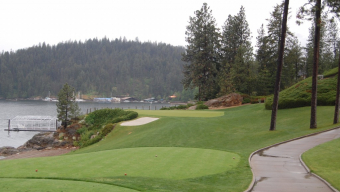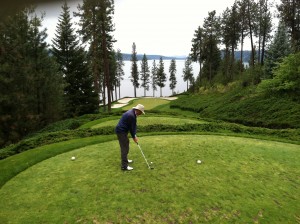COEUR D’ALENE, Idaho – The Floating Green at The Coeur d’Alene golf course – the only hole on earth surrounded entirely by water — is just a small part of a big family of strikingly beautiful and challenging par-3s.
Sure, the breathtaking, and intimidating, No. 14 at the lakeside resort course can make (or break) your day. You get emotional high when your tee shot stays dry, but agony sets in when the ball finds the watery grave, as outlined in this story.
Such is the case with the Floating Green.
But long before you reach that world-renowned piece of floating beauty, there are four other par-3 holes. They are so picturesque and challenging that they could be signature holes at numerous courses.
“We are proud of all of our par-3s,” said Andy Mackimmie, the facility’s head golf professional. “We call it our ‘fabulous five’. They are all fantastic holes.”
Indeed they are and I was among the fortunate members of the Northwest Golf Media Association to recently participate in a two-day, 36-hole excursion.
Before hitting my first shot of the first round, I spent a few minutes with Mackimmie discussing each of the par-3s and getting some much-needed advice from him on how to play them. Then I went out and played them MY way.
Here are the results:
No. 3, 125 yards, pin back left.
How you should play the hole (pictured above):
“No. 3 is right on the waterfront and there’s a pin placement we can put on the back left. That one, obviously, tests fate a little bit. I almost always play to the middle of the green.”
How I played the hole:
I was torn between a pitching wedge and a 9-iron. The pin was in the back so I went with the longer club, figuring it would be better to be a little long than a little short. The direction was superb, but the ball settled in the back fringe. No problem. I two-putted for my third consecutive par of the round – and that is no small accomplishment for me.
No. 5, 125 yards, pin back center.
How you should play the hole:
“No. 5 was renovated in 2003. It was just kind of a ho-hum, 100-yard par-3 back when we built the golf course. But in the 2003 remodel, we actually dug down about 22 feet and it exposed the view of the lake you now get when you are on the tee. We can play it from about 150 (yards) from the very back pin placement. The view of the lake is spectacular.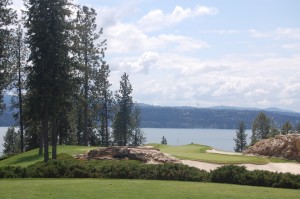
“As we started digging, a rock we didn’t even know was there started to expose itself. That’s when we decided to leave the rock in place and put this big bunker — one of the world’s largest contained bunkers — in. It originally derived, I think, from a golf course in the Mediterranean that our owner, Mr. (Duane) Hagadone, played.
“Our No. 5 is modeled after that hole. It has three tiers with the back tier being the highest. The middle and front tiers slope down to the front. You can have all kinds of pin placements, but no matter where the pin is located, I play for the middle of the green. Unless you are feeling really good about your wedge, aim for the middle.
“It’s a short hole (pictured above) but you have to stay focused. I’ve seen some big scores there, especially when someone hits the rock or lands in the sand. Hitting from one trap to another is easy to do. It’s a tricky hole.”
How I played the hole:
I was confident that my trusty 9-iron was the right club. Maybe so, but I hit it a little thin, the ball went a little right and landed in the right-side bunker. As I surveyed the next shot, all I could see past the hole was another bunker – and a whole lot of trouble beyond it.
My sand wedge lifted the ball out of the sand and onto the fringe past the hole. I two-putted for a bogey and was perfectly happy with it, especially after taking a “9” on the previous hole. The less said about No. 4 the better.
As a sidelight note, we played the course again the following day and the pin was in the front. I hit a pitching wedge hole high, about two feet from the cup and made the putt for my only birdie of the day. Truth be known, it was the only birdie of the two days.
No. 6, 145 yards, pin front right.
How you should play the hole:
“No. 6 is a gorgeous hole. When we originally built the course, it was probably our No. 2 signature hole (behind No. 14). Now it’s a tossup between Nos. 5-6 as the second signature hole. From the back tee, it drops close to 80 feet and offers the best views of the golf course. What always has struck me are those towering pines standing behind the back and sides of the green. It frames the hole real well. We added the bunkers in the 2003 remodel and it’s wise to play a club less, unless the breeze coming At you.”
How I played the hole:
I usually hit an 8-iron about 135 yards, but the elevation drop persuaded me to use that club on the 145-yard hole. My distance was good, but pulled the shot into the left bunker. I blasted out to about 25 feet and two-putted for a bogey. Bob Sherwin, one of my player partners and the CEO of GolfersWest.com, majestically lofted an 8-iron to within two feet of the cup and made the putt for his first birdie during the two-day visit.
No. 12, 185 yards, pin back right.
How you should play the hole:
“No. 12 is a tough hole. We can actually play it from about 250 yards from the championship tees, extending it back during the remodel. We have water on the left, the back and even a little on the right. The prevailing wind is right to left, so the shot to play there is play out to right a little and let the breeze bring it in or have a little bit of a draw.”
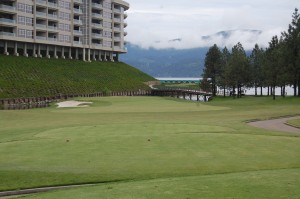 How I played the hole (pictured left):
How I played the hole (pictured left):
I hit a 4-utility with a slight draw and sure enough, the ball hit in front of the green and rolled to within 15 feet of the cup. I missed the birdie putt by about 3 inches and settled for a par.”
And that leaves only one par-3:
No. 14, 144 yards, pin middle left.
How you should play the hole:
“No. 14 is the one hole where you just have to hit the dart there. I have hit the water many times and the difficulty of the hole speaks for itself. I always tell people that confidence is the key when you get to a hole like that. It intimidates you, but it is a big green. The whole island is 15,000 square feet so there is a lot of room — almost like catcher’s mitt look to it. You know you are not going to go long and go over the back into the water.
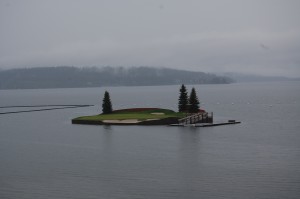 “The key is to swing smooth and let it fly. The yardage varies from 80 yards for ladies, just a chip shot I tell them, and maxes out at about 220.”
“The key is to swing smooth and let it fly. The yardage varies from 80 yards for ladies, just a chip shot I tell them, and maxes out at about 220.”
How I played the hole (pictured on the left):
I used a 6-iron I the direction was perfect. But I didn’t get the altitude I wanted and the ball rolled past the hole and into the back bunker. Dry was good, but I still was faced with a tough shot. With water all around, I cautiously played the ball it out of the trap, landing in the rough, just short of the putting surface. I putted it anyway. The ball rolled past the hole and down the slope, leaving yet another difficult putt. Two putts later, I was on my way back to the boat for the short ride back to shore – not at all happy with a double bogey.
But I returned to Seattle with fond memories of all 18 holes at The Coeur d’Alene and can’t wait to go back.





